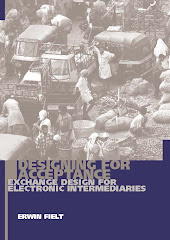This post is part of a series that explores service-oriented business models based on different perspectives on service. In a previous post we discussed the service as product perspective. In this post we address the service as process perspective.
Subsequent to the service product approach and the IHIP characteristics, many newer definitions emphasise services as processes and focus more on the interactions between the customer and provider and the role of the customer as co-producer. Grönroos (2007) and Johnston and Clark (2004) stress state that, from the customers’ perspective, service is the combination of the customers’ direct experience of the service process and their perception of the outcome of that process. Grönroos (2006) defines service as ‘a process consisting of a series of more or less intangible activities, that normally, but not necessarily, take place in interactions between the customer and service employees and/or physical resources or goods and/or systems of the service provider, which are provided as solutions to customer problems.’ Teboul (2006) differentiates between processes in the front-stage (service) where the interaction with the customer takes place, and processes in the back-stage (production).
Frequently, the service encounter is the service from the customer’s point of view (Bitner, Booms, & Tetreault, 1990). This makes it the moment of truth for the provider. While some service marketing use a broad definition for service encounter encompassing any interaction element (e.g., Shostack, 1985), many focused on the personal interactions between customers and employees in the service encounters (e.g., Bitner et al., 1990). However, nowadays this ‘high-touch, low-tech’ paradigm is expanded to include technology-based (enabling employees) and technology-supported (enabling customers) services (Bitner, Brown, & Meuter, 2000). The service as process perspective also has a strong relation with the customer relation as the provider-customer interaction offers opportunities for building a relationship, even in a single encounter (C. Grönroos, 2007).
For business models based on the service as process, the Value Proposition is more targeted at the interaction as perceived by the customer, for example, the service quality and the customer experience. This has also a strong relation with the Key Activities and Key Resources of the core organization, as these have to be targeted at delivering the Value Proposition. The Key Activities and Key Resources are also affected by the role of the customer as co-producer. This means taking into account the Activities and Resources of the Customer Segments and the opportunities and challenges that come with this kind of customer involvement. Moreover, because of the role of the service encounter and the customer relationship in the service as process perspective, the Channels and Relationship elements will also be important for business models based on this perspective.
According to Grönroos (2007) the basic service package (as discussed in the service as product above) is not the same as the service offering from the customer’s viewpoint. The service package considers primarily what the customer receives from a service in terms of outcome related features. However, it neglects how the customer receives the service in terms of process related features. The latter should be seen as an integral part of total service offering. Grönroos refers to the ‘augmented service offering’, which includes next to the outcome features (i.e. the service package consisting of core, enabling and enhancing services), three process related features: accessibility of the service, interactions with the service organization, and customer participation. This augmented service offering can the starting point for a business model pattern that provides an integrated approach to service-oriented business models with respect to the outcome and process features of a service offering.
In addition, the different aspects of service as a process in relation to the business model framework, customer experience, customer relationship and co-production, can also be used as service-oriented business model patterns. For example, a customer experience pattern can support in envisioning a business model for an online service where the value proposition is based on, or enhanced by, the experience, design-based activities and resources that enable developing and delivering this experience, and, if possible, a revenue model based on or levering the experience (e.g. using freenium). A well-known example on an organization having a strong customer experience pattern in its business models is Apple.
Moreover, the growing importance of the Internet has opened up new opportunities and requires rethinking traditional service logic based on the ‘high-touch, low-tech’ paradigm. In particular we see a growing rise of the technology-enabled self-service model at the expensive of the traditional, people-focussed full service model. However, there may also be a rise in new, technology-enabled full service model, as the SaaS example introduced earlier.
References
Bitner, M. J., Booms, B. H., & Tetreault, M. S. (1990). The Service Encounter: Diagnosing Favorable and Unfavorable Incidents. Journal of Marketing, 54(1), 71-84.
Bitner, M. J., Brown, S. W., & Meuter, M. L. (2000). Technology Infusion in Service Encounters. Journal of the Academy of Marketing Science, 28(1), 138-149.
Grönroos, C. (2006). Adopting a service logic for marketing. Marketing Theory, 6(3), 317-333.
Grönroos, C. (2007). Service Management and Marketing: Customer Management in Service Competition (3 ed.). Chichester, UK: Wiley.
Johnston, R., & Clark, G. (2004). Service Operations Management (2 ed.). Harlow, UK: Prentice Hall.
Shostack, G. L. (1985). Planning the Service Encounter. In J. A. Czepiel, M. R. Solomon & C. F. Surprenant (Eds.), The Service Encounter: Managing employee/customer interaction in service businesses (pp. 243-254). Lexington, MA: Lexington Books.
Teboul, J. (2006). Service is front-stage. New York: Palgrave Macmillan.









